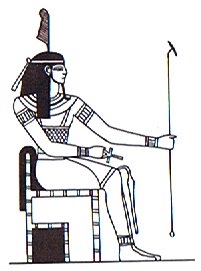|
TRANSLATIONS
This is the 9th period and nine is implying the dark underworld. In Pa6-62 we can see that the sun now is below the horizon, i.e. he has gone down into the world under us. The mid top flame in Pa5-60 is peculiarly thick, another way of regarding his disappearance: he has gone up into the Mountain. In Pa5-61 we can see at left a sign meaning a 'dead' person and at right a desiccated arm ending in the Y-shape meaning underworld. The similarities between sun before 'awakening' and after 'going to sleep' is clear:
Pa5-60 has a thick top middle flame because that is a sign meaning - presumably - mountain. The idea of a connection between dead people and mountains is widespread, e.g. in ancient Egypt:
Hathor emerging through the side of a mountain = the necropolis. (Wilkinson) And in ancient Sumer: "The early Sumerian temple tower with the hieratically organized little city surrounding it, where everyone played his role according to the rules of a celestially inspired divine game, supplied the model of paradise that we find, centuries later, in the Hindu-Buddhist imagery of the world mountain, Sumeru, whose jeweled slopes, facing the four directions, peopled on the west by sacred serpents, on the south by gnomes, on the north by earth giants, and on the east by divine musicians, rose from the mid-point of the earth as the vertical axis of the egg-shaped universe, and bore on its quadrangular summit the palatial mansions of the deathless gods, whose towered city was known as Amaravati, 'The Town Immortal'. But it was the model also of the Greek Olympus, the Aztec temples of the sun, and Dante's holy mountain of Purgatory, bearing on its summit the Earthly Paradise." (Campbell) And in Polynesia: " ... 'My child', said Makea now in a tone of deep sorrow, 'there has been a bad omen for us. When I performed the tohi ceremony over you I missed out a part of the prayers. I remembered it too late. I am afraid this means that you are going to die.' 'What's she like, Hine nui te Po?' asked Maui. 'Look over there', said Makea, pointing to the ice-cold mountains beneath the flaming clouds of sunset. 'What you see there is Hine nui, flashing where the sky meets the earth. Her body is like a woman's, but the pupils of her eyes are greenstone and her hair is kelp. Her mouth is that of a barracuda, and in the place where men enter her she has sharp teeth of obsidian and greenstone.' ..." (Maori Myths) The top of the sun glyph can be read according to the old Chinese sign for mountains:
We can observe in the rightmost example that the shape is like a cock's comb. Mountains are connected to sunset and therefore also with the (temporary) death of the 'cock' (a symbol of fire, e.g. 'flaming clouds of sunset' above). Sometimes a mountain indeed shows us that it contains fire for real, the volcanoe: "... only the old or the very old man is able to proceed to the end of the journey, the ultimate land of the dead, which, like the paradise of the Hawaiian chiefs, is on the summit of a great volcano. There the dead dance every night among the flames; whereas men of the younger age grades, not having completed the course of their initiation into the mystery of death through life, remain in the entrance cave ..." (Campbell) So as the sun slowly wanes after his maximum at noon, going down after having reached his apex, there is another mountain at the other side of the horizon, a dark mountain for the dead. The glyph Pa5-61 has at left what we may read as a feather and at right an uplifted old arm ending in Y, a sign of defeat (to death) in contrast to V for victory and vigorous life. Winston Churchill was not the originator of V for victory. As I have read somewhere, it was used much earlier among the English peasants revolting against their French rulers, and then this V was a symbol for a forked agricultural implement used as a weapon against the French troops. But this kind of thinking is moving along the wrong track: nothing originates, it only appears, disappears, and reappears. V arrives before Y in the alphabeth, but after Y there comes Z and then A again etc. This Y-sign in rongorongo is a forked limb. But generally seen such a simple sign as Y connects many - for us - different phenomena such as the tongue of a snake, the sprout of maize, the crotch of a woman. In a magic world they all belong together, fashinating us. The ancient Egyptian feather sign which normally is associated with Maat, Goddess of Justice, presumably originates in the idea of the weightless soul leaving the dead body and rising up into the air. The god of air, Shuh, has a feather as his emblem.  In Pa5-62 we can observe, if we are attentive, slight differences serving as cues for those with trained eyes:
The glyph at left (1st period) points upwards, the one at right downwards. Also: the right one is slimmer. By now we understand such signs. |
||||||||||||||||||||||




